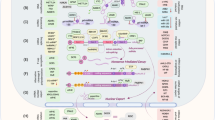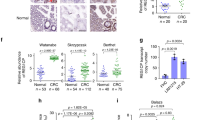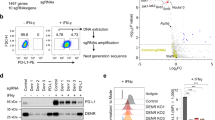Abstract
A subset of promoters bidirectionally expresses long non-coding RNAs (ncRNAs) of unknown function and protein-coding genes (PCGs) in parallel. Here, we define a set of 1107 highly conserved human bidirectional promoters that mediate the linked expression of long ncRNAs and PCGs. Depletion of the long ncRNA expressed from the RB1 promoter, ncRNA-RB1, reveals regulatory effects different from the RB1-controlled transcriptional program. ncRNA-RB1 positively regulates the expression of calreticulin (CALR) that in response to certain therapeutic interventions can translocate from the endoplasmic reticulum to the cell surface, hence activating anticancer immune responses. Knockdown of ncRNA-RB1 in tumor cells reduced expression of CALR, impaired the translocation of the protein to the cell surface upon treatment with anthracylines and consequently inhibited the cellular uptake by macrophages. In conclusion, co-transcription of ncRNA-RB1 and RB1 provides a positive link between the expression of the two tumor suppressors RB1 and the immune-relevant CALR protein. This regulatory interplay exemplifies disease-relevant co-regulation of two distinct gene products, in which loss of expression of one oncosuppressor protein entails the abolition of additional tumor-inhibitory mechanisms.
This is a preview of subscription content, access via your institution
Access options
Subscribe to this journal
Receive 50 print issues and online access
$259.00 per year
only $5.18 per issue
Buy this article
- Purchase on Springer Link
- Instant access to full article PDF
Prices may be subject to local taxes which are calculated during checkout






Similar content being viewed by others
References
Orom UA, Shiekhattar R . Long noncoding RNAs usher in a new era in the biology of enhancers. Cell 2013; 154: 1190–1193.
Cabili MN, Trapnell C, Goff L, Koziol M, Tazon-Vega B, Regev A et al. Integrative annotation of human large intergenic noncoding RNAs reveals global properties and specific subclasses. Genes Dev 2011; 25: 1915–1927.
Derrien T, Johnson R, Bussotti G, Tanzer A, Djebali S, Tilgner H et al. The GENCODE v7 catalog of human long noncoding RNAs: analysis of their gene structure, evolution, and expression. Genome Res 2012; 22: 1775–1789.
Zhao J, Sun BK, Erwin JA, Song JJ, Lee JT . Polycomb proteins targeted by a short repeat RNA to the mouse X chromosome. Science 2008; 322: 750–756.
Rinn JL, Kertesz M, Wang JK, Squazzo SL, Xu X, Brugmann SA et al. Functional demarcation of active and silent chromatin domains in human HOX loci by noncoding RNAs. Cell 2007; 129: 1311–1323.
Wang KC, Yang YW, Liu B, Sanyal A, Corces-Zimmerman R, Chen Y et al. A long noncoding RNA maintains active chromatin to coordinate homeotic gene expression. Nature 2011; 472: 120–124.
Lai F, Orom UA, Cesaroni M, Beringer M, Taatjes DJ, Blobel GA et al. Activating RNAs associate with Mediator to enhance chromatin architecture and transcription. Nature 2013; 494: 497–501.
Melo CA, Drost J, Wijchers PJ, van de Werken H, de Wit E, Oude Vrielink JA et al. eRNAs are required for p53-dependent enhancer activity and gene transcription. Mol Cell 2013; 49: 524–535.
Trimarchi T, Bilal E, Ntziachristos P, Fabbri G, Dalla-Favera R, Tsirigos A et al. Genome-wide mapping and characterization of notch-regulated long noncoding RNAs in acute leukemia. Cell 2014; 158: 593–606.
Orom UA, Derrien T, Beringer M, Gumireddy K, Gardini A, Bussotti G et al. Long noncoding RNAs with enhancer-like function in human cells. Cell 2010; 143: 46–58.
Guttman M, Amit I, Garber M, French C, Lin MF, Feldser D et al. Chromatin signature reveals over a thousand highly conserved large non-coding RNAs in mammals. Nature 2009; 458: 223–227.
Core LJ, Waterfall JJ, Lis JT . Nascent RNA sequencing reveals widespread pausing and divergent initiation at human promoters. Science 2008; 322: 1845–1848.
Neil H, Malabat C, d'Aubenton-Carafa Y, Xu Z, Steinmetz LM, Jacquier A . Widespread bidirectional promoters are the major source of cryptic transcripts in yeast. Nature 2009; 457: 1038–1042.
Preker P, Nielsen J, Kammler S, Lykke-Andersen S, Christensen MS, Mapendano CK et al. RNA exosome depletion reveals transcription upstream of active human promoters. Science 2008; 322: 1851–1854.
Seila AC, Calabrese JM, Levine SS, Yeo GW, Rahl PB, Flynn RA et al. Divergent transcription from active promoters. Science 2008; 322: 1849–1851.
Sigova AA, Mullen AC, Molinie B, Gupta S, Orlando DA, Guenther MG et al. Divergent transcription of long noncoding RNA/mRNA gene pairs in embryonic stem cells. Proc Natl Acad Sci USA 2013; 110: 2876–2881.
Flynn RA, Almada AE, Zamudio JR, Sharp PA . Antisense RNA polymerase II divergent transcripts are P-TEFb dependent and substrates for the RNA exosome. Proc Natl Acad Sci USA 2011; 108: 10460–10465.
Almada AE, Wu X, Kriz AJ, Burge CB, Sharp PA . Promoter directionality is controlled by U1 snRNP and polyadenylation signals. Nature 2013; 499: 360–363.
Ntini E, Jarvelin AI, Bornholdt J, Chen Y, Boyd M, Jorgensen M et al. Polyadenylation site-induced decay of upstream transcripts enforces promoter directionality. Nat Struct Mol Biol 2013; 20: 923–928.
Ozsolak F, Song JS, Liu XS, Fisher DE . High-throughput mapping of the chromatin structure of human promoters. Nat Biotechnol 2007; 25: 244–248.
Wu X, Sharp PA . Divergent transcription: a driving force for new gene origination? Cell 2013; 155: 990–996.
Rhee HS, Pugh BF . Genome-wide structure and organization of eukaryotic pre-initiation complexes. Nature 2012; 483: 295–301.
Marquardt S, Escalante-Chong R, Pho N, Wang J, Churchman LS, Springer M et al. A chromatin-based mechanism for limiting divergent noncoding transcription. Cell 2014; 157: 1712–1723.
Andersson R, Gebhard C, Miguel-Escalada I, Hoof I, Bornholdt J, Boyd M et al. An atlas of active enhancers across human cell types and tissues. Nature 2014; 507: 455–461.
Zhang L, Wang P, Ding Q, Wang Z . Transcriptional directionality of the human insulin-degrading enzyme promoter. Mol Cell Biochem 2013; 382: 237–242.
Uesaka M, Nishimura O, Go Y, Nakashima K, Agata K, Imamura T . Bidirectional promoters are the major source of gene activation-associated non-coding RNAs in mammals. BMC Genomics 2014; 15: 35.
Polson A, Reisman D . The bidirectional p53-Wrap53beta promoter is controlled by common cis- and trans-regulatory elements. Gene 2014; 538: 138–149.
Hung T, Wang Y, Lin MF, Koegel AK, Kotake Y, Grant GD et al. Extensive and coordinated transcription of noncoding RNAs within cell-cycle promoters. Nat Genet 2011; 43: 621–629.
Grote P, Wittler L, Hendrix D, Koch F, Wahrisch S, Beisaw A et al. The tissue-specific lncRNA Fendrr is an essential regulator of heart and body wall development in the mouse. Dev Cell 2013; 24: 206–214.
Chao MP, Jaiswal S, Weissman-Tsukamoto R, Alizadeh AA, Gentles AJ, Volkmer J et al. Calreticulin is the dominant pro-phagocytic signal on multiple human cancers and is counterbalanced by CD47. Sci Transl Med 2010; 2: 63ra94.
Chao MP, Majeti R, Weissman IL . Programmed cell removal: a new obstacle in the road to developing cancer. Nat Rev Cancer 2012; 12: 58–67.
Obeid M, Tesniere A, Ghiringhelli F, Fimia GM, Apetoh L, Perfettini JL et al. Calreticulin exposure dictates the immunogenicity of cancer cell death. Nat Med 2007; 13: 54–61.
Harrow J, Frankish A, Gonzalez JM, Tapanari E, Diekhans M, Kokocinski F et al. GENCODE: the reference human genome annotation for The ENCODE Project. Genome Res 2012; 22: 1760–1774.
Adachi N, Lieber MR . Bidirectional gene organization: a common architectural feature of the human genome. Cell 2002; 109: 807–809.
Manning AL, Dyson NJ . pRB a tumor suppressor with a stabilizing presence. Trends Cell Biol 2011; 21: 433–441.
Hoesel B, Schmid JA . The complexity of NF-kappaB signaling in inflammation and cancer. Mol Cancer 2013; 12: 86.
Luo J . Glycogen synthase kinase 3beta (GSK3beta) in tumorigenesis and cancer chemotherapy. Cancer Lett 2009; 273: 194–200.
Fruman DA, Rommel C . PI3K and cancer: lessons, challenges and opportunities. Nat Rev Drug Discov 2014; 13: 140–156.
Yang MQ, Koehly LM, Elnitski LL . Comprehensive annotation of bidirectional promoters identifies co-regulation among breast and ovarian cancer genes. PLoS Comput Biol 2007; 3: e72.
Sakai T, Ohtani N, McGee TL, Robbins PD, Dryja TP . Oncogenic germ-line mutations in Sp1 and ATF sites in the human retinoblastoma gene. Nature 1991; 353: 83–86.
Shiio Y, Yamamoto T, Yamaguchi N . Negative regulation of Rb expression by the p53 gene product. Proc Natl Acad Sci USA 1992; 89: 5206–5210.
Shan B, Chang CY, Jones D, Lee WH . The transcription factor E2F-1 mediates the autoregulation of RB gene expression. Mol Cell Biol 1994; 14: 299–309.
Savoysky E, Mizuno T, Sowa Y, Watanabe H, Sawada J, Nomura H et al. The retinoblastoma binding factor 1 (RBF-1) site in RB gene promoter binds preferentially E4TF1, a member of the Ets transcription factors family. Oncogene 1994; 9: 1839–1846.
Gill RM, Hamel PA, Zhe J, Zacksenhaus E, Gallie BL, Phillips RA . Characterization of the human RB1 promoter and of elements involved in transcriptional regulation. Cell Growth Differ 1994; 5: 467–474.
Sowa Y, Shiio Y, Fujita T, Matsumoto T, Okuyama Y, Kato D et al. Retinoblastoma binding factor 1 site in the core promoter region of the human RB gene is activated by hGABP/E4TF1. Cancer Res 1997; 57: 3145–3148.
Hamel PA, Gill RM, Phillips RA, Gallie BL . Transcriptional repression of the E2-containing promoters EIIaE, c-myc, and RB1 by the product of the RB1 gene. Mol Cell Biol 1992; 12: 3431–3438.
Lenhard B, Sandelin A, Carninci P . Metazoan promoters: emerging characteristics and insights into transcriptional regulation. Nat Rev Genet 2012; 13: 233–245.
Gardai SJ, McPhillips KA, Frasch SC, Janssen WJ, Starefeldt A, Murphy-Ullrich JE et al. Cell-surface calreticulin initiates clearance of viable or apoptotic cells through trans-activation of LRP on the phagocyte. Cell 2005; 123: 321–334.
Pandey RR, Mondal T, Mohammad F, Enroth S, Redrup L, Komorowski J et al. Kcnq1ot1 antisense noncoding RNA mediates lineage-specific transcriptional silencing through chromatin-level regulation. Mol Cell 2008; 32: 232–246.
Carrieri C, Cimatti L, Biagioli M, Beugnet A, Zucchelli S, Fedele S et al. Long non-coding antisense RNA controls Uchl1 translation through an embedded SINEB2 repeat. Nature 2012; 491: 454–457.
Wakano C, Byun JS, Di LJ, Gardner K . The dual lives of bidirectional promoters. Biochim Biophys Acta 2012; 1819: 688–693.
Michalak M, Groenendyk J, Szabo E, Gold LI, Opas M . Calreticulin a multi-process calcium-buffering chaperone of the endoplasmic reticulum. Biochem J 2009; 417: 651–666.
Siepel A, Bejerano G, Pedersen JS, Hinrichs AS, Hou M, Rosenbloom K et al. Evolutionarily conserved elements in vertebrate, insect, worm, and yeast genomes. Genome Res 2005; 15: 1034–1050.
Langmead B, Trapnell C, Pop M, Salzberg SL . Ultrafast and memory-efficient alignment of short DNA sequences to the human genome. Genome Biol 2009; 10: R25.
Trapnell C, Pachter L, Salzberg SL . TopHat: discovering splice junctions with RNA-Seq. Bioinformatics 2009; 25: 1105–1111.
Trapnell C, Williams BA, Pertea G, Mortazavi A, Kwan G, van Baren MJ et al. Transcript assembly and quantification by RNA-Seq reveals unannotated transcripts and isoform switching during cell differentiation. Nature Biotechnol 2010; 28: 511–515.
Bhatt DM, Pandya-Jones A, Tong AJ, Barozzi I, Lissner MM, Natoli G et al. Transcript dynamics of proinflammatory genes revealed by sequence analysis of subcellular RNA fractions. Cell 2012; 150: 279–290.
Acknowledgements
Work in the laboratories of GK and OK are suppported by the Ligue contre le Cancer (équipe labelisée); Agence National de la Recherche (ANR); Association pour la recherche sur le cancer (ARC); Cancéropôle Ile-de-France; AXA Chair for Longevity Research; Institut National du Cancer (INCa); Fondation Bettencourt-Schueller; Fondation de France; Fondation pour la Recherche Médicale (FRM); the European Commission (ArtForce); the European Research Council (ERC); the LabEx Immuno-Oncology; the SIRIC Stratified Oncology Cell DNA Repair and Tumor Immune Elimination (SOCRATE); the SIRIC Cancer Research and Personalized Medicine (CARPEM); and the Paris Alliance of Cancer Research Institutes (PACRI). Work in the laboratory of UAØ is supported by the German Ministry of education and research through the Alexander von Humboldt Foundation Sofja Kovalevskaja Award.
Author Contributions
A-SM conceived the experiments, performed all experiments except those in Figure 6 and interpreted the data. XH and SR performed the experiments in Figure 6. EN and AM performed bioinformatic analysis. GK and OK conceived the experiments in Figure 6, supervised research and interpreted data. UAØ conceived the experiments, supervised research and interpreted data. A-SM, GK, OK and UAØ wrote the manuscript. All authors read and approved the manuscript.
Author information
Authors and Affiliations
Corresponding author
Ethics declarations
Competing interests
The authors declare no conflict of interest.
Additional information
Supplementary Information accompanies this paper on the Oncogene website
Rights and permissions
About this article
Cite this article
Musahl, AS., Huang, X., Rusakiewicz, S. et al. A long non-coding RNA links calreticulin-mediated immunogenic cell removal to RB1 transcription. Oncogene 34, 5046–5054 (2015). https://doi.org/10.1038/onc.2014.424
Received:
Revised:
Accepted:
Published:
Issue Date:
DOI: https://doi.org/10.1038/onc.2014.424
This article is cited by
-
A four immune-related long noncoding RNAs signature as predictors for cervical cancer
Human Cell (2022)
-
CRlncRC: a machine learning-based method for cancer-related long noncoding RNA identification using integrated features
BMC Medical Genomics (2018)
-
The transcriptional profiles and functional implications of long non-coding RNAs in the unfolded protein response
Scientific Reports (2018)
-
Bericht vom 5. Symposium des Deutschen Forschungsverbunds Blasenkarzinom
Der Urologe (2016)



